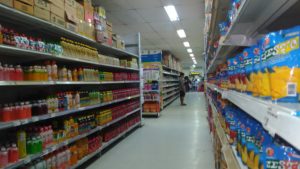2.11: Why It Matters- Retail Environmental Analysis
- Page ID
- 45004
Why evaluate different types of retail institutions?
Think about your local grocery store or supermarket. You probably enter into the produce section or perhaps the deli or bakery departments. The milk, butter, and meat sections are probably located at the back of the store, while the center of the store is filled with several rows of packaged items like soup, cereal, and peanut butter. There might be displays of chips, cake mixes, or seasonal items at the end of each aisle. The frozen foods are probably relegated to one or two aisles, either in open freezer chests or behind closed freezer doors. The cash registers are at the front of the store, along with displays of soft drinks, candy, and magazines.

Regardless of where you live and where you shop, it’s likely that the store you imagine is very similar to the one described and those imagined by others throughout the country. That’s because the retail grocery industry has not changed much since the 1950s when the supermarket concept first flourished in growing suburban America. There have been innovations in technology, like UPC scanners and self-checkout kiosks, and there have been a few changes to product assortment and services, like the addition of florists, coffee bars, and banks. But, in most ways, the grocery stores of your parents and grandparents are not unlike the the grocery stores of today.
However, your local grocery store might not be the only place you shop for food. Are there some stores you like best for quick trips, like convenience stores? Do you ever go to a club store like Costco to buy food in bulk?
While the typical supermarket hasn’t changed much in over sixty years, what has changed is the number of places and number of ways you can get your groceries. And because more changes to food retailing are on the horizon, it’s important to understand the differences in retail formats, including how they compete with each other.
Contributors and Attributions
- Why It Matters: Retail Environmental Analysis. Authored by: Patrick Williams. Provided by: Lumen Learning. License: CC BY: Attribution
- Grocery Aisle. Authored by: Joey Fernandez. License: Public Domain: No Known Copyright

